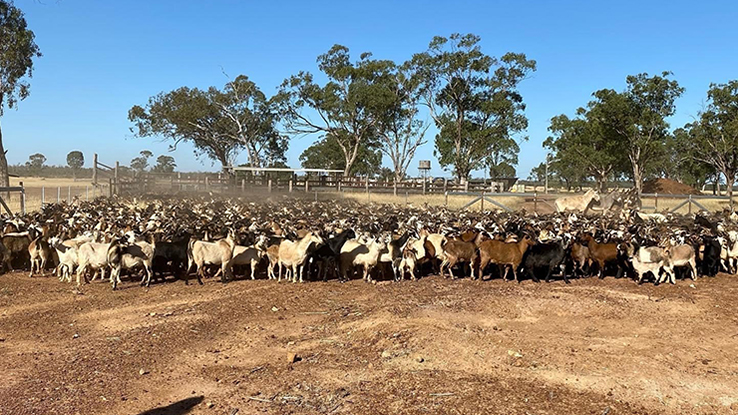
A well-calculated decision to transition a former cattle property into a 100% goat operation is paying dividends for young Queensland producers, Greg and Katie Honor.
The Honors have been breeding Rangeland goats for the past four years on their 7,273 hectare property, ‘Glenmore’, near Surat, and are now in the next phase of building their goat business.
More than 90 current and potential goat producers were given an insight into how the Honors are making the best use of existing resources to create a profitable business when they hosted a ‘Going into Goats’ production field day in May, supported by MLA.
Making the move into goats
When the Honors bought ‘Glenmore’ in 2017, they recognised the landscape was better suited to goats than cattle and invested in infrastructure accordingly to facilitate the transition.
Improvements have included converting cattle yards with a three-way draft and ProWay bulk handler, new fencing, and more watering points, with paddocks set up to enable ease of mustering.
“What we’re trying to do is get the best bang for buck out of the country that we’ve got,” Greg said.
“The property has a lot of timber, including Brigalow, Box, Bendee and Wilga, and regrowth is a problem. It is also marginal, having an average annual rainfall of 500mm.
“To produce beef, you’ve got to grow a lot of grass, and to have a lot of grass you need rain.
“For us, going into goats was about managing drought tolerance and risk, and creating a profitable business to support our family.
“In an area with a lower than 760mm rainfall, it’s high risk trying to produce cattle. Goats are a lot more tolerant and resilient and will eat plants that cattle won’t eat, such as browse and shrubs.
“The previous owners were running 350 cows, whereas we’re running 6,000 nannies.
“We had agistment cattle here for two years when we first came here, and at the end of the drought, going into 2019, we had to destock completely, but we still bought in 2,000 goats on a 1,620-hectare paddock and they were fine at a time when cattle were struggling.”
Business model
The Honors started their herd by purchasing 2,200 nannies and have retained nannies to build their herd.
“The property is divided into four, 1,620-hectare paddocks, but we’re only utilising half the place at the moment because we’ve just finished fencing the last paddock and we’re developing another paddock,” Greg said.
“Next year, the third paddock comes into rotation. Our aim is to have two, 610-to-1,620-hectare paddocks as what we call grower areas, where we can grow weaners out in.”
While retaining nannies to build their herd, the Honors also sell 6- to 9-month-old weaner nannies into the restocker market and are currently receiving $150/head.
“We also produce a meatworks article with our weaner billies, which we hold on to for three to six months post weaning to get them to a liveweight of 30-40kg and target carcase weight of 15-20kg,” Greg said.
“We’re aiming to sell about 6,000 a year to processors and restockers.”
Billies are processed at Carey Brothers, Warwick, and Western Meat Exporters, Charleville.
Forage preferences
Greg said forage preferences changed depending on the season.
“We have a range of grass species including buffel, Mitchell grass, wire grass and kangaroo grass, but particularly now when the grass has hayed off, the goats are predominantly on the browse and not eating much grass at all,” Greg said.
“We do notice between November and March, they like the grass, particularly when it’s green, but once it hays off, we see them put that burden load onto the timber which is great for the grass because when it rains, we’ve got a good body of feed to start with.
“The first thing they go to in the paddock is any Wilga, Silver Leaf Ironbark and Box suckers.”
“If you’ve got the right country type with the browse on it, that’s your drought insurance. I think people will look at browse country differently in the next couple of years.
“We’re still learning and are just realising how much there is to know about the industry. For any producers looking to get into goats, the MLA Going into Goats video series is a great place to start.”
Greg and Katie’s top tips:
- Know your bottleneck before starting to spend money on any development. For example, money on water infrastructure might be needed as well as money on fencing in the beginning.
- Focus on the things that will increase your profitability – new yards might be nice to have but they don’t make you money. Consider reducing distance between water to maintain weight and evenly distribute grazing burden.
- Ensure your sires are the best you can afford, but you shouldn’t need to spend more than $500-$1,000.







